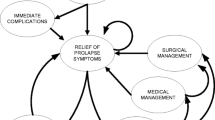Abstract
Introduction and hypothesis
To estimate the risk of repeat surgery for recurrent prolapse or mesh removal after vaginal mesh versus native tissue repair for anterior vaginal wall prolapse.
Methods
We utilized longitudinal, adjudicated, healthcare claims from 2005 to 2010 to identify women ≥18 years who underwent an anterior colporrhaphy (CPT 57420) with or without concurrent vaginal mesh (CPT 57267). The primary outcome was repeat surgery for anterior or apical prolapse or for mesh removal/revision; these outcomes were also analyzed separately. We utilized Kaplan–Meier curves to estimate the cumulative risk of each outcome after vaginal mesh versus native tissue repair. Cox proportional hazards models were used to estimate the hazard ratio (HR) for vaginal mesh versus native tissue repair, adjusted for age, concurrent hysterectomy, and concurrent or recent sling.
Results
We identified 27,809 anterior prolapse surgeries with 49,658 person-years of follow-up. Of those, 6,871 (24.7%) included vaginal mesh. The 5-year cumulative risk of any repeat surgery was significantly higher for vaginal mesh versus native tissue (15.2 % vs 9.8 %, p <0.0001) with a 5-year risk of mesh revision/removal of 5.9%. The 5-year risk of surgery for recurrent prolapse was similar between vaginal mesh and native tissue groups (10.4 % vs 9.3 %, p = 0.70. The results of the adjusted Cox model were similar (HR 0.93, 95%CI: 0.83, 1.05).
Conclusions
The use of mesh for anterior prolapse was associated with an increased risk of any repeat surgery, which was driven by surgery for mesh removal. Native tissue and vaginal mesh surgery had similar 5-year risks for surgery for recurrent prolapse.
Similar content being viewed by others
References
FDA Safety Communication: Update on serious complications associated with transvaginal placement of surgical mesh for pelvic organ prolapse. Issued on 13 July 2011. http://www.fda.gov/medicaldevices/safety/alertsandnotices/ucm262435.htm. Accessed on 12 June 2012
Dangerous medical devices: most medical implants have never been tested for safety. Consumer Reports Magazine, May 2012. Accessed on 9 July 2012 at: http://www.consumerreports.org/cro/magazine/2012/04/cr-investigates-dangerous-medical-devices/index.htm
FDA Executive Summary: Surgical mesh for the treatment of women with pelvic organ prolapse and stress urinary incontinence, 8–9 September 2011. http://www.fda.gov/downloads/AdvisoryCommittees/CommitteesMeetingMaterials/MedicalDevices/MedicalDevicesAdvisoryCommittee/ObstetricsandGynecologyDevices/UCM270402.pdf. Accessed on 12 June 2012
Olsen AL, Smith VJ, Bergstrom JO, Colling JC, Clark AL (1997) Epidemiology of surgically managed pelvic organ prolapse and urinary incontinence. Obstet Gynecol 89(4):501–506
Altman D, Vayrynen T, Engh ME, Axelsen S, Falconer C (2011) Anterior colporrhaphy versus transvaginal mesh for pelvic-organ prolapse. N Engl J Med 364(19):1826–1836
Nieminen K, Hiltunen R, Takala T et al (2010) Outcomes after anterior vaginal wall repair with mesh: a randomized, controlled trial with a 3 year follow-up. Am J Obstet Gynecol 203(3):235 e1–e8
Foon R, Toozs-Hobson P, Latthe PM (2008) Adjuvant materials in anterior vaginal wall prolapse surgery: a systematic review of effectiveness and complications. Int Urogynecol J Pelvic Floor Dysfunct 19(12):1697–1706
Jia X, Glazener C, Mowatt G et al (2008) Efficacy and safety of using mesh or grafts in surgery for anterior and/or posterior vaginal wall prolapse: systematic review and meta-analysis. BJOG 115(11):1350–1361
Nguyen JN, Burchette RJ (2008) Outcome after anterior vaginal prolapse repair: a randomized controlled trial. Obstet Gynecol 111(4):891–898
Thomson Reuters MarketScan® Commercial Claims and Encounters Database, 2000–2009. Source: RED BOOK® and MarketScan® are registered trademarks of Thomson Reuters (Healthcare) Inc. http://thomsonreuters.com/products_services/healthcare/healthcare_products/pharmaceuticals/mktscan_res_db/. Accessed on 12 June 2012
DeNavas-Walt C, Proctor BD, Smith JC (2011) US Census Bureau, Current Population Reports, P60–239, Income, Poverty, and Health Insurance Coverage in the United States: 2010. U.S. Government Printing Office, Washington, D.C. http://www.census.gov/prod/2011pubs/p60-239.pdf. Accessed on 24 June 2012
Menefee SA, Dyer KY, Lukacz ES, Simsiman AJ, Luber KM, Nguyen JN (2011) Colporrhaphy compared with mesh or graft-reinforced vaginal paravaginal repair for anterior vaginal wall prolapse: a randomized controlled trial. Obstet Gynecol 118(6):1337–1344
Withagen MI, Milani AL, den Boon J, Vervest HA, Vierhout ME (2011) Trocar-guided mesh compared with conventional vaginal repair in recurrent prolapse: a randomized controlled trial. Obstet Gynecol 117(2 Pt 1):242–250
Maher CM, Feiner B, Baessler K, Glazener CM (2011) Surgical management of pelvic organ prolapse in women: the updated summary version Cochrane review. Int Urogynecol J 22(11):1445–1457
Sung VW, Rogers RG, Schaffer JI et al (2008) Graft use in transvaginal pelvic organ prolapse repair: a systematic review. Obstet Gynecol 112(5):1131–1142
Hiltunen R, Nieminen K, Takala T et al (2007) Low-weight polypropylene mesh for anterior vaginal wall prolapse: a randomized controlled trial. Obstet Gynecol 110(2 Pt 2):455–462
Carey M, Higgs P, Goh J et al (2009) Vaginal repair with mesh versus colporrhaphy for prolapse: a randomised controlled trial. BJOG 116(10):1380–1386
Lunardelli JL, Auge AP, Lemos NL et al (2009) Polypropylene mesh vs. site-specific repair in the treatment of anterior vaginal wall prolapse: preliminary results of a randomized clinical trial. Rev Col Bras Cir 36(3):210–216
Nguyen JN, Jakus-Waldman SM, Walter AJ, White T, Menefee SA (2012) Perioperative complications and reoperations after incontinence and prolapse surgeries using prosthetic implants. Obstet Gynecol 119(3):539–546
Funding
This project was supported by grant number K02HS017950 from the Agency for Healthcare Research and Quality (AHRQ; to M.J.F) and grant number K23HD068404 from the Eunice Kennedy Shriver National Institute of Child Health & Human Development (to J.M.W). The content is solely the responsibility of the authors and does not necessarily represent the official views of the Agency for Healthcare Research and Quality.
Conflicts of interest
None.
Author information
Authors and Affiliations
Corresponding author
Rights and permissions
About this article
Cite this article
Jonsson Funk, M., Visco, A.G., Weidner, A.C. et al. Long-term outcomes of vaginal mesh versus native tissue repair for anterior vaginal wall prolapse. Int Urogynecol J 24, 1279–1285 (2013). https://doi.org/10.1007/s00192-013-2043-9
Received:
Accepted:
Published:
Issue Date:
DOI: https://doi.org/10.1007/s00192-013-2043-9




